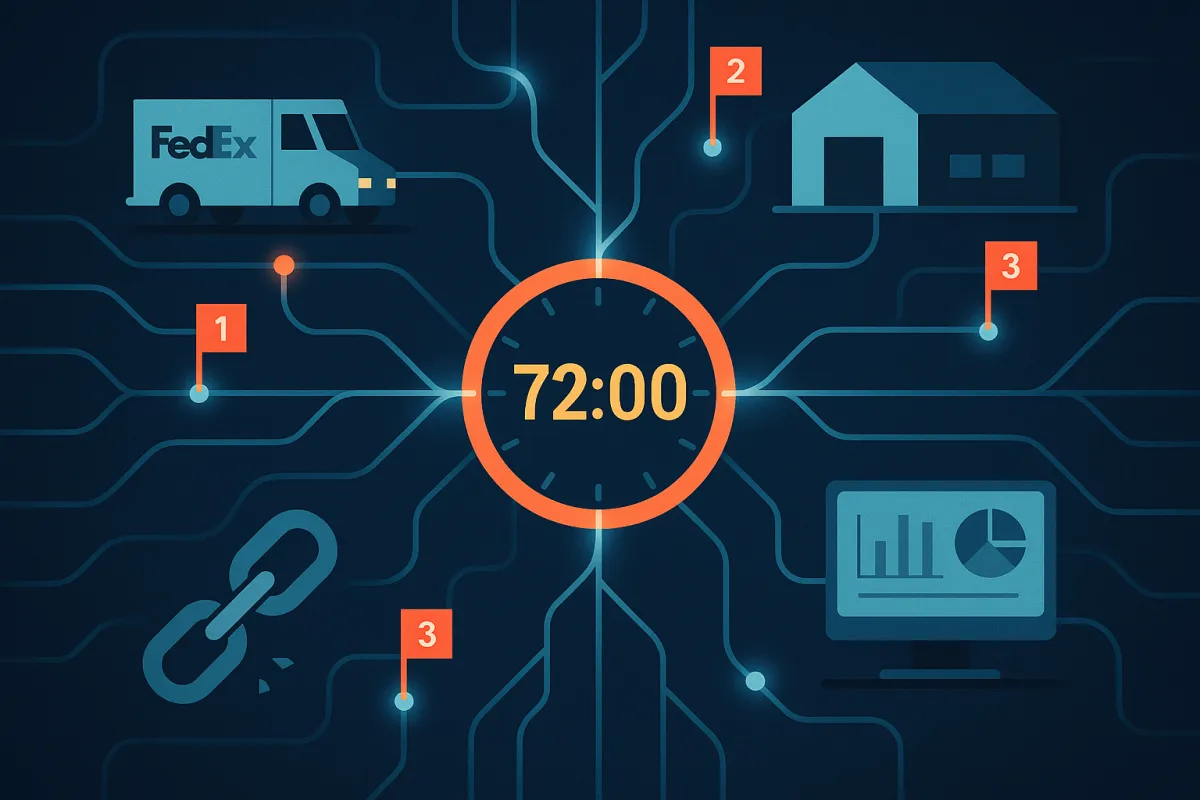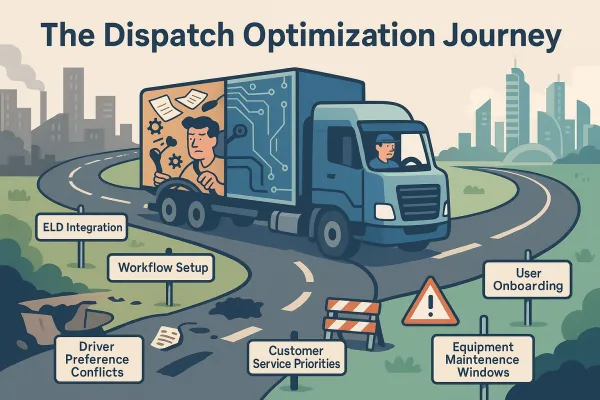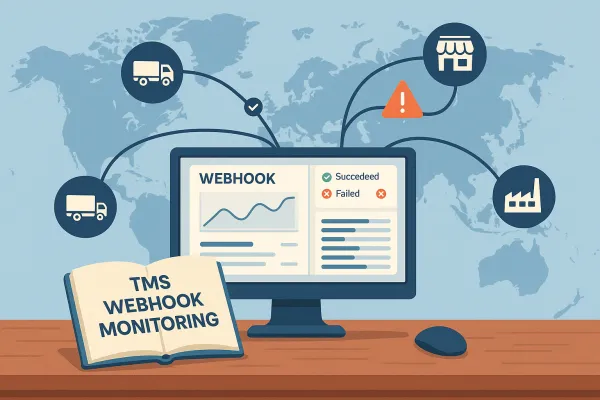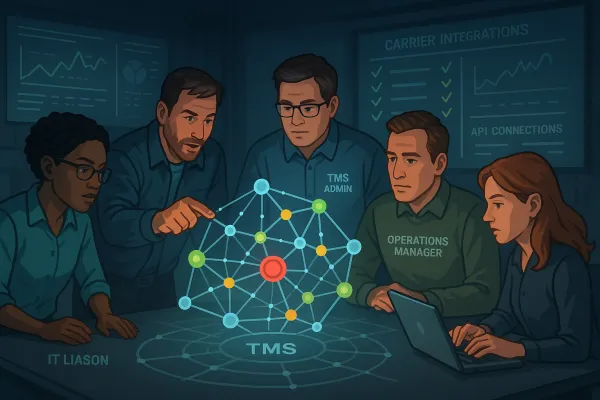TMS Integration Testing: The 72-Hour Protocol That Prevents 90% of Go-Live Carrier Failures

Three weeks before your TMS go-live, you discover that FedEx's rate API returns empty responses for 15% of your shipments. Your carrier integration testing showed green across the board just two months ago. Sound familiar?
Up to 40 percent of implementations fail by some estimates, and most of those failures trace back to integration issues that surface after launch. The problem isn't just broken APIs. Integrating a 3PL transportation management system often fails due to disconnected systems, poor visibility, and outdated technology. These challenges slow down decision-making, increase errors, and limit control across multi-partner logistics networks.
Here's the uncomfortable truth: your TMS testing protocol determines whether you catch these problems before your customers do. Over the past over 4 years, we have collected data on on more than 332 outages that affected ShipEngine API users. Each outage represents dozens of companies scrambling to explain to customers why their packages aren't shipping.
Why Most TMS Integration Testing Fails (The Reality Check)
McKinsey says that 80% of logistics service providers and 68% of shippers believe costs pose the most significant challenge when implementing. To ensure that your spending stays on the right track, establish deadlines, operational goals, and budgetary limitations for each specific phase of implementation. But cost pressure leads teams to cut corners on the one thing that prevents go-live disasters: systematic integration testing.
The typical testing approach hits three predictable failure patterns. First, teams test against carrier sandbox environments that behave nothing like production APIs. Major carriers are actively migrating away from SOAP-based APIs, with FedEx retiring their legacy Web Services in May 2024 and moving to RESTful APIs, while UPS transitioned from XML protocols to OAuth 2.0-secured REST endpoints. Your testing needs to account for these transitions.
Second, most teams focus on happy-path scenarios. Rate quotes work perfectly when you test standard packages between major cities. The problems surface when you need same-day delivery to rural Montana or hazmat shipments during peak season. Integrating with carrier APIs is a non-trivial exercise and most IT departments are already in project overload mode.
Third, testing typically happens in isolation from your actual business logic. Teams validate that carrier APIs respond correctly but never test how those responses integrate with your order management system, inventory updates, or billing workflows. Integrating TMS with existing enterprise systems like ERP (Enterprise Resource Planning), warehouse management systems (WMS), and supplier/customer platforms can be both complex and time-consuming. Achieving seamless data flow and compatibility across these systems is essential for optimal operational efficiency.
The 72-Hour Testing Protocol Framework
This protocol compresses comprehensive TMS integration testing into a focused three-day cycle that catches 90% of the issues that typically surface post-launch. Unlike traditional testing approaches that drag on for weeks, this framework prioritizes the critical paths that actually break in production.
Day 1 focuses on API foundations and authentication flows. Day 2 validates data mappings and system integrations. Day 3 runs end-to-end scenarios and failure recovery protocols. Each day builds on the previous, creating a systematic approach that modern TMS platforms like Cargoson, Manhattan TMS, and Oracle WMS Cloud can support through built-in testing environments.
The key difference from traditional testing: you're not trying to validate every possible scenario. You're identifying the failure points that will impact real shipments on day one of production.
Day 1 - Carrier API & Authentication Testing
Start with authentication validation across all carrier connections. UPS replaced its entire existing API infrastructure, deprecating access key-based authorization in favor of OAuth 2.0 security models, with post-June 3, 2024, any transaction with UPS mandating this new OAuth security model. If your testing doesn't account for OAuth token refresh cycles, you'll face authentication failures within hours of go-live.
Create test scripts that validate rate quotes for your top 20% of shipping lanes by volume. These represent 80% of your actual shipping patterns. Don't waste time testing obscure origin-destination pairs that ship twice per year. Focus on the routes that will break your customer promises if they fail.
Test service validation with real package dimensions and weights from your order history. Carriers reject shipments for dimensional weight violations, restricted ZIP codes, and service level mismatches. Your test data should reflect actual packages, not theoretical 1-pound boxes shipping to major metros.
Authentication flow checklist:
- OAuth token generation and refresh cycles
- API rate limiting behavior under normal load
- Service availability during peak hours
- Error response handling for invalid credentials
Day 2 - Data Flow & Mapping Validation
Day 2 validates the data contracts between your TMS and external systems. This is where most implementations actually break. These TMS implementation mistakes create data silos that undermine the entire TMS value proposition. Instead of centralized visibility and streamlined workflows, companies end up with multiple systems that require constant manual intervention to stay synchronized.
Test order creation flows using real purchase order data from your ERP system. Don't use sanitized test data that masks field mapping issues. Copy production orders from your top 10 customers and validate that all required fields populate correctly in carrier API calls.
Status update synchronization requires particular attention. Carrier webhooks fail at rates that would bankrupt a traditional SaaS platform. The business costs of webhook failures can be substantial, including lost sales, customer dissatisfaction, regulatory penalties, and operational disruption costs, and in carrier integrations, these failures happen far more frequently than other domains.
Test billing data reconciliation with actual carrier invoices. Download last month's FedEx and UPS invoices, then validate that your TMS can match line items to specific shipments. This catches billing integration problems before they create accounting nightmares.
Data validation test cases:
- Order field mapping between ERP and TMS
- Address validation and standardization
- Shipment status webhook processing
- Invoice reconciliation accuracy
Day 3 - End-to-End Scenarios & Failure Recovery
Day 3 validates complete shipment lifecycles under realistic conditions. End to end testing (E2E testing) refers to a software testing method that involves testing an application's workflow from beginning to end. This test aims to replicate real user scenarios, so that the system can be validated for integration and data integrity.
Create test scenarios that mirror your actual business processes. If your customers typically place orders by 2 PM for next-day delivery, test order processing, carrier selection, label generation, and tracking updates within that timeframe. Use real customer addresses from your order history, not generic test addresses.
Failure recovery testing matters more than perfect-world scenarios. When FedEx's API went down at 2 AM and took out shipping for 40% of your tenants, you learned something important about circuit breakers. Traditional circuit breaker patterns don't handle multi-tenant carrier integration gracefully—when one carrier fails, the blast radius shouldn't encompass every · Your carrier experiences an outage. You're left unable to calculate shipping rates and customers aren't impressed. Label generation duplicates when your retry logic fires twice. Rate shopping fails when your cache logic stores partial responses. Welcome to the carrier integration reliability challenge.
Test carrier failover scenarios by temporarily blocking API calls to your primary carrier. Does your TMS automatically route shipments to backup carriers? Can your team manually override carrier selection when primary options fail?
Recovery protocol test scenarios:
- Primary carrier API unavailable
- Label generation failure mid-batch
- Tracking data synchronization delays
- Billing discrepancy resolution workflows
Critical Test Scenarios Checklist
These test cases cover the integration failure points that create customer-facing problems. Skip the edge cases that happen once per year. Focus on scenarios that could impact multiple shipments per day.
Rate Shopping Validation: Test rate comparison across carriers using packages that represent 80% of your shipping volume. Validate that residential delivery surcharges, fuel adjustments, and dimensional weight calculations match carrier invoices.
Label Generation Testing: Generate shipping labels for your top product SKUs using real customer addresses. Test international shipments with customs documentation if you ship globally. Validate that generated labels print correctly on your actual label printers.
Tracking Update Processing: Monitor webhook delivery for shipment status updates. Test what happens when tracking webhooks arrive out of sequence or contain partial information. Your customer service team needs accurate tracking data to handle delivery inquiries.
Billing Reconciliation: Download actual carrier invoices and validate that your TMS matches charges to specific shipments. Test scenarios where carriers apply unexpected surcharges or zone skips that don't appear in rate quotes.
Pass/fail criteria should be binary. Either rates match actual carrier pricing within 5%, or they don't. Either labels generate successfully, or they fail. Avoid subjective evaluation criteria that create false confidence.
Monitoring & Documentation Protocol
Document configuration decisions during testing, not after launch. Document technical specifications, integration points and standard operating procedures of key business processes and exceptions. When carrier APIs change unexpectedly, your documentation determines whether troubleshooting takes hours or days.
Create test result templates that capture specific failure points. Don't just note that "UPS integration failed." Record the exact error codes, payload contents, and system responses. This documentation becomes your troubleshooting playbook when similar issues arise in production.
Log all API calls during testing with timestamps, request payloads, and response codes. Many TMS platforms like Descartes, Transporeon, and Oracle support API logging through their monitoring dashboards. This log data helps identify intermittent issues that only surface under specific conditions.
Error escalation procedures need contact information for technical support at each carrier. Have phone numbers and email addresses for FedEx, UPS, and DHL technical support teams. When integration issues impact customer shipments, you need direct escalation paths.
Common Failure Patterns & Quick Fixes
API timeout issues typically result from inadequate connection pooling or retry logic. You can expect the same will happen with multi-carrier API integration. Chances are you will be asked to automate other transportation workflows across the enterprise that don't lend themselves to easy API integration. Configure connection timeouts to 30 seconds for rate quotes and 60 seconds for label generation. Shorter timeouts create unnecessary failures during peak periods.
Authentication refresh protocols need automatic retry mechanisms. When OAuth tokens expire, your TMS should refresh tokens automatically without manual intervention. Test token refresh under load to ensure the process doesn't create authentication gaps during busy shipping periods.
Data synchronization recovery requires fallback procedures when webhook delivery fails. Your carrier API monitoring setup decides whether you catch integration failures before your customers do. Implement polling mechanisms that check shipment status every 4 hours when webhooks don't arrive as expected.
Troubleshooting decision tree should prioritize customer-facing impacts. Start with issues affecting label generation and shipment booking. Address reporting and analytics problems after core shipping functionality works correctly. Your operations team needs working shipment processes more than perfect dashboard metrics.
Vendor escalation requires pre-established contacts at each carrier's technical support organization. Don't rely on general customer service numbers when API integrations fail. Have direct contacts for FedEx Web Services, UPS API Support, and DHL eCommerce technical teams.
This 72-hour protocol won't catch every possible integration issue, but it identifies the problems that create immediate customer impact. Test the scenarios that matter, document the results systematically, and establish clear escalation procedures. Your go-live success depends on finding integration problems before your customers do.





